Roaming the Community for a Close Look into People's Lives Fieldwork Methods and Attitudes for Discovering What Makes a Community Attractive
Roaming the Community for a Close Look into People’s Lives Fieldwork Methods and Attitudes for Discovering What Makes a Community Attractive
With a keen awareness of the importance of interaction and involvement, Professor Kato seeks to learn from the community through fieldwork activities that bring him and his students into direct contact with the strengths and gentleness of the people who comprise a community. We talked to him about the Exploring the Power of Place Project that he is pursuing.
KATO, Fumitoshi
Professor
Faculty of Environment and Information Studies
From the Classroom to the Community
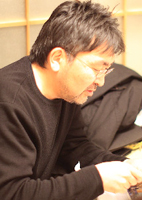 As a college student, I joined an economic geography study group that focused mainly on researching the economic activities and locational issues of local communities. Along the way, I became increasingly interested in the daily lives of people and decided to go to the United States to study communication theory. My specific area of interest was interpersonal communication and facilitation. Some years later when I began to teach at Keio University’s Shonan Fujisawa Campus (SFC), my initial focus was communication in the classroom setting and the key factors that go into creating a learning environment. However, the focus of my attention gradually began to transcend the campus setting and expanded to include the urban environment and the local communities surrounding us. Following this direction, I launched the Exploring the Power of Place Project in 2003. In this project, we consider the concept of place from the perspective of communication theory and move around a local community to discover what we call “good places” that are filled with a spirit of creativity and vitality. The operational question is: “How are good places created and developed in a local community?” We make the maximum use of our five senses as we roam a community and observe a given place in as great detail as possible, paying particular care to carefully collecting both tangible and intangible things that grab our attention. In the final analysis, we are engaged in the process of trying to understand interpersonal relations as we come face-to-face with our own individual identities. The activities of the project revolve around the tasks of designing methods (concepts, tools, and practices for researching, learning, and expressing) for understanding the lives and daily activities of people, and actually putting the usefulness of these methods to test in the field and assessing the findings.
As a college student, I joined an economic geography study group that focused mainly on researching the economic activities and locational issues of local communities. Along the way, I became increasingly interested in the daily lives of people and decided to go to the United States to study communication theory. My specific area of interest was interpersonal communication and facilitation. Some years later when I began to teach at Keio University’s Shonan Fujisawa Campus (SFC), my initial focus was communication in the classroom setting and the key factors that go into creating a learning environment. However, the focus of my attention gradually began to transcend the campus setting and expanded to include the urban environment and the local communities surrounding us. Following this direction, I launched the Exploring the Power of Place Project in 2003. In this project, we consider the concept of place from the perspective of communication theory and move around a local community to discover what we call “good places” that are filled with a spirit of creativity and vitality. The operational question is: “How are good places created and developed in a local community?” We make the maximum use of our five senses as we roam a community and observe a given place in as great detail as possible, paying particular care to carefully collecting both tangible and intangible things that grab our attention. In the final analysis, we are engaged in the process of trying to understand interpersonal relations as we come face-to-face with our own individual identities. The activities of the project revolve around the tasks of designing methods (concepts, tools, and practices for researching, learning, and expressing) for understanding the lives and daily activities of people, and actually putting the usefulness of these methods to test in the field and assessing the findings.
What the Exploring the Power of Place Project Hopes to Accomplish
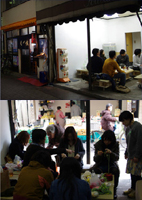 People tend to think of the Exploring the Power of Place Project as a project for community development and revitalization. But that does not capture the whole truth. Community revitalization is normally associated with developing mechanisms for encouraging and stimulating economic activities. However, as can be readily imagined, this is not an easy task. In the Exploring the Power of Place Project, we made the choice of approaching this challenge from the perspective of communication theory, which means that we start by walking around the community to get a close look into the daily lives of the individuals who comprise the community. In recent years, it has frequently been pointed out that what is taken for granted by local residents can actually prove to be extremely fresh and attractive to outsiders, leading to the rediscovery of numerous tangible and intangible values that previously remained hidden or forgotten. When visiting a community for the first time with students, many things both tangible and intangible can be very new and refreshing. Instead of going straight to the question of how a community can be revitalized, what we want to do is to interact with the residents, become acquainted with their daily activities, and to shed light on what strikes us as being attractive in the lives that are being lived there. In this context, I feel that it is very important to correctly appreciate our position as outsiders as we consider the urban environment and community.
People tend to think of the Exploring the Power of Place Project as a project for community development and revitalization. But that does not capture the whole truth. Community revitalization is normally associated with developing mechanisms for encouraging and stimulating economic activities. However, as can be readily imagined, this is not an easy task. In the Exploring the Power of Place Project, we made the choice of approaching this challenge from the perspective of communication theory, which means that we start by walking around the community to get a close look into the daily lives of the individuals who comprise the community. In recent years, it has frequently been pointed out that what is taken for granted by local residents can actually prove to be extremely fresh and attractive to outsiders, leading to the rediscovery of numerous tangible and intangible values that previously remained hidden or forgotten. When visiting a community for the first time with students, many things both tangible and intangible can be very new and refreshing. Instead of going straight to the question of how a community can be revitalized, what we want to do is to interact with the residents, become acquainted with their daily activities, and to shed light on what strikes us as being attractive in the lives that are being lived there. In this context, I feel that it is very important to correctly appreciate our position as outsiders as we consider the urban environment and community.
Producing Posters
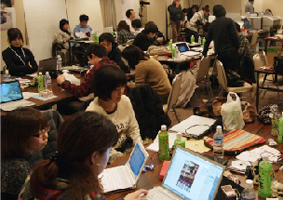 As part of this project, over the past five years, I have been conducting research caravans that have taken me and my students to various parts of Japan from Hokkaido in the north to Okinawa in the south. Our initial approach was to interview local residents, to photograph places that we found to be attractive, and to combine the results of our study to produce research reports. These activities provided us with a very interesting opportunity to consider the feelings of those who were being studied. We examined the possibility that unconsciously we may have been acting inconsiderately toward the subjects of our study. For example, during our fieldwork, we take photographs of our subjects and promise to send them copies. But quite often, time slips away and we find that we have not kept our promise. In another example, we mail copies of our completed reports to the communities we study. But in hindsight, we realized that our reports tended to be stiff in terms of style and content and probably did not make for very interesting reading (particularly for the residents that we had studied). Faced with this realization, we tried a very simple solution, which was to produce something tangible while we were still there in the community. In other words, we opted for finishing our homework right there and then. Thereafter, we have experimented with various ways of finishing our homework, which include producing postcards and video clips. The most positive response has come from a poster project where we create posters consisting of photographs of people working in the community combined with captions and descriptions.
As part of this project, over the past five years, I have been conducting research caravans that have taken me and my students to various parts of Japan from Hokkaido in the north to Okinawa in the south. Our initial approach was to interview local residents, to photograph places that we found to be attractive, and to combine the results of our study to produce research reports. These activities provided us with a very interesting opportunity to consider the feelings of those who were being studied. We examined the possibility that unconsciously we may have been acting inconsiderately toward the subjects of our study. For example, during our fieldwork, we take photographs of our subjects and promise to send them copies. But quite often, time slips away and we find that we have not kept our promise. In another example, we mail copies of our completed reports to the communities we study. But in hindsight, we realized that our reports tended to be stiff in terms of style and content and probably did not make for very interesting reading (particularly for the residents that we had studied). Faced with this realization, we tried a very simple solution, which was to produce something tangible while we were still there in the community. In other words, we opted for finishing our homework right there and then. Thereafter, we have experimented with various ways of finishing our homework, which include producing postcards and video clips. The most positive response has come from a poster project where we create posters consisting of photographs of people working in the community combined with captions and descriptions.
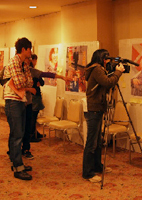 Normally, we spend two days and one night in the community that we are studying. We collect materials on the first day and go back to our lodgings to produce posters during the evening. On the second day, the completed posters are printed and the members of the community are invited to an exhibition of these posters. So this is how it works: we visit a community where we have never been before; we interview people that we have never met before; and, on the following day, we invite these people to see the posters that we have just completed. The response to the posters can be varied. Inevitably, there are those who give a thumbs down with comments such as, “I never said that!” and “Didn’t you have a better picture of me?” But we also see the happiness that our posters can bring to the members of the community. Either way, the students and residents look at the posters together and take their conversations to a higher level. The exciting thing about this approach is that it produces direct and on-the-spot feedback. One of our most memorable moments came in the winter of 2009 during our visit to the northern coastal city of Kamaishi in Iwate Prefecture. Reviewing a series of photographs taken of an elderly man during an interview, the students noticed the subtle changes in the old man’s expressions in photos taken when talking about his grandchildren, when talking about his wife and when talking about work. So, the students created a poster that focused on these changes in facial expression. When the old man saw the poster on the next day, he was so overcome with emotion that he began to cry. This had an electrifying effect, not only on the students that had produced the poster, but also on the other project members that had observed what had happened. This experience that brought tears to many eyes left a lasting impression on us.
Normally, we spend two days and one night in the community that we are studying. We collect materials on the first day and go back to our lodgings to produce posters during the evening. On the second day, the completed posters are printed and the members of the community are invited to an exhibition of these posters. So this is how it works: we visit a community where we have never been before; we interview people that we have never met before; and, on the following day, we invite these people to see the posters that we have just completed. The response to the posters can be varied. Inevitably, there are those who give a thumbs down with comments such as, “I never said that!” and “Didn’t you have a better picture of me?” But we also see the happiness that our posters can bring to the members of the community. Either way, the students and residents look at the posters together and take their conversations to a higher level. The exciting thing about this approach is that it produces direct and on-the-spot feedback. One of our most memorable moments came in the winter of 2009 during our visit to the northern coastal city of Kamaishi in Iwate Prefecture. Reviewing a series of photographs taken of an elderly man during an interview, the students noticed the subtle changes in the old man’s expressions in photos taken when talking about his grandchildren, when talking about his wife and when talking about work. So, the students created a poster that focused on these changes in facial expression. When the old man saw the poster on the next day, he was so overcome with emotion that he began to cry. This had an electrifying effect, not only on the students that had produced the poster, but also on the other project members that had observed what had happened. This experience that brought tears to many eyes left a lasting impression on us.
The Bokuto University Experiment
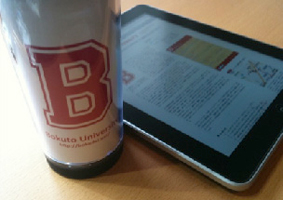 What happens when we have more time than the normal two days and one night to conduct a study? It cannot be denied that our normal schedule forces us to rush through our tasks. So, we began to ask ourselves, “What if we had more time to complete our activities? Maybe we would be able to do something far more interesting if we could interact more intimately with our subjects.” We experimented with this approach in the Bokuto District of Tokyo’s Sumida City during the period of October 2010 to March 2011. The Bokuto District refers to the northern half of Sumida City, and is marked off by three rivers: the Sumida River, the Arakawa River, and the Kita-Jikken River, which flows adjacent to the Tokyo Sky Tree. What we did was to establish the Bokuto University in our target area. This was by no means a formal institution of higher learning as specified in the School Education Act, and the Kyojima Campus, where our activities were centered, was nothing more than an empty storefront that we had rented in the local shopping arcade. But to add some reality to our university, we issued student IDs, created a system for earned credits, printed graduation diplomas, and made a series of Bokuto University goods. The idea was that the entire Bokuto District constituted an integrated campus. The content of the classes and activities that were offered varied considerably, but the unifying concept was that students would be encouraged to interact and communicate with local residents to the greatest extent possible. For example, we started a knitting class that involved collecting all sorts of discarded materials from around the Bokuto District and incorporating these into the knitting productions. With classes being held in the Kyojima Campus located in the shopping arcade, passersby would drop in and teach the students to knit. This created a very interesting learning environment and added to the excitement of designing and creating a place for learning located within the community.
What happens when we have more time than the normal two days and one night to conduct a study? It cannot be denied that our normal schedule forces us to rush through our tasks. So, we began to ask ourselves, “What if we had more time to complete our activities? Maybe we would be able to do something far more interesting if we could interact more intimately with our subjects.” We experimented with this approach in the Bokuto District of Tokyo’s Sumida City during the period of October 2010 to March 2011. The Bokuto District refers to the northern half of Sumida City, and is marked off by three rivers: the Sumida River, the Arakawa River, and the Kita-Jikken River, which flows adjacent to the Tokyo Sky Tree. What we did was to establish the Bokuto University in our target area. This was by no means a formal institution of higher learning as specified in the School Education Act, and the Kyojima Campus, where our activities were centered, was nothing more than an empty storefront that we had rented in the local shopping arcade. But to add some reality to our university, we issued student IDs, created a system for earned credits, printed graduation diplomas, and made a series of Bokuto University goods. The idea was that the entire Bokuto District constituted an integrated campus. The content of the classes and activities that were offered varied considerably, but the unifying concept was that students would be encouraged to interact and communicate with local residents to the greatest extent possible. For example, we started a knitting class that involved collecting all sorts of discarded materials from around the Bokuto District and incorporating these into the knitting productions. With classes being held in the Kyojima Campus located in the shopping arcade, passersby would drop in and teach the students to knit. This created a very interesting learning environment and added to the excitement of designing and creating a place for learning located within the community.
Be a Participant, Not an Observer
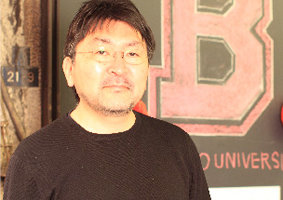 When we explain our activities, from time to time someone asks, “What meaning is there in creating posters? What purpose do the posters serve?” Faced with these questions, the truth is that we don’t have a very compelling answer on how our activities can be immediately useful. However, there is one thing that is certain, which is that our daily lives consist of multi-layered tapestries whose warp and woof are stringed with myriad threads of individual stories. The objective of our project does not stop with presenting individual cases. Ultimately, our aim is to draw close to the lives of average ordinary people, to shed light on the vital forces that animate each individual, and to identify the factors that add to the attractiveness of a place where people gather. To go to a community where one has never been before and to interview people whom one has never met before can be quite a demanding task for students with no previous experience. But there is much that the students can learn through direct experience, and it is my hope that through this process of communication students will be encouraged to develop and hone their powers and abilities for taking action. In this sense, I believe it is very important for us to be active participants instead of passive observers because, in the final analysis, the essence of both tangible and intangible things cannot be seen if we avoid direct involvement.
When we explain our activities, from time to time someone asks, “What meaning is there in creating posters? What purpose do the posters serve?” Faced with these questions, the truth is that we don’t have a very compelling answer on how our activities can be immediately useful. However, there is one thing that is certain, which is that our daily lives consist of multi-layered tapestries whose warp and woof are stringed with myriad threads of individual stories. The objective of our project does not stop with presenting individual cases. Ultimately, our aim is to draw close to the lives of average ordinary people, to shed light on the vital forces that animate each individual, and to identify the factors that add to the attractiveness of a place where people gather. To go to a community where one has never been before and to interview people whom one has never met before can be quite a demanding task for students with no previous experience. But there is much that the students can learn through direct experience, and it is my hope that through this process of communication students will be encouraged to develop and hone their powers and abilities for taking action. In this sense, I believe it is very important for us to be active participants instead of passive observers because, in the final analysis, the essence of both tangible and intangible things cannot be seen if we avoid direct involvement.
A Brief Background of Professor
KATO, Fumitoshi
Professor Kato graduated in 1985 from the Faculty of Economics of Keio University and earned an MA from the Graduate School of Economics of the same university in 1988. Following this, in 1991, he earned another MA from the University of Pennsylvania Annenberg School for Communication and received his PhD from Rutgers University School of Communication and Information in 2003. After working as a research assistant at the Faculty of Environmental Information of Keio University and as an associate professor in the Faculty of Intercultural Communication of Ryukoku University, he was appointed associate professor of the Faculty of Faculty of Environmental Information of Keio University in 2001. Professor Kato assumed his current post in 2010. His areas of specialty are communication theory, media theory, and qualitative research methods. Professor Kato’s major publications include, as co-author, Gemingu shimuleshon (Gaming simulation) (Tokyo: Nikkagirenn [JUSE Press], 1998) and, as author, Kyampuron: atarashii firudowaku (Camp theory: a new fieldwork) (Tokyo: Keio University Press, 2009).
(03 October 2011)
Archive